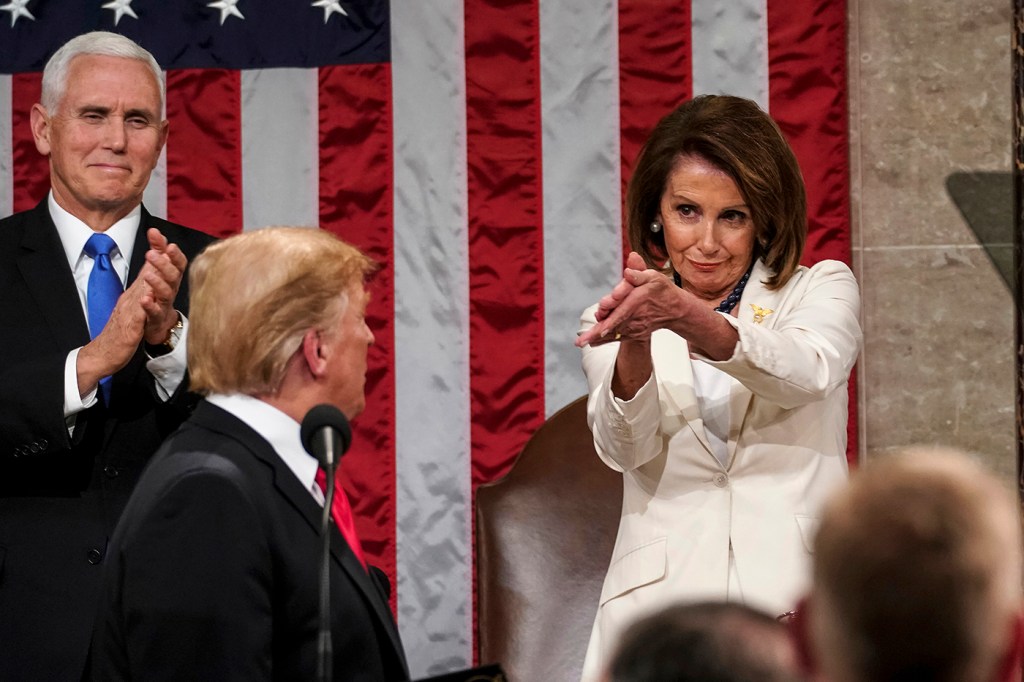A body language expert analyzes the ‘Pelosi Clap’ and other highlights from the State of the Union

It was President Donald Trump who delivered the State of the Union address Tuesday, but House Speaker Nancy Pelosi was the one “who stole the show in terms of people paying attention to body language,” said Laura Dudley, a behavioral analyst at Northeastern University.
The “Pelosi Clap,” as it’s become known in viral memes and news reports, “was such an interesting moment,” said Dudley, who is also a clinical professor at the university who specializes in body language.
The moment came as Trump said that the 116th Congress, ushered in a century after women gained the right to vote, includes “more women serving in Congress than at any time before.”
Pelosi, stationed behind Trump’s left shoulder, stood and clapped pointedly at the remark, extending her arms and staring with “laser focus” at the president, Dudley observed.
Other congresswomen in the House chambers Tuesday, many of whom were wearing white in homage to the suffragette movement, stood and cheered as well, though not until after a “noticeable pause, as if everyone were wondering where he was going,” Dudley said.
There are two interpretations of Pelosi’s pointed applause and tight focus, Dudley said.
“Either she was supporting women, and celebrating with the president, or it was an ironic moment, where she’s clapping for the women without supporting Trump’s statements,” she said.
Dudley cautioned that body language analysis isn’t an exact science, because it’s impossible to divine a person’s private thoughts with 100 percent certainty.
Sometimes Pelosi’s reactions were directed at her congressional party.
“There were at least two times during the address when Pelosi held up her hand towards the Democrats, seemingly warning them from reacting strongly to Trump’s statements,” Dudley said. “She did this once when Trump spoke out against war and ‘investigations,’ and a second time when he described the caravans at the border.”
Other moments caught Dudley’s eye as well.
The president spent most of the evening facing his left, toward members of his own Republican Party, she noticed.
This could have been unintentional, Dudley said, the result of positive behavior reinforcement.
“Any of us who’ve given a talk or spoken at a meeting where our message clearly resonates with some people and not with others can understand that,” she said. “Oftentimes we just unintentionally direct our attention to those people who seem to agree with us.” Since Republicans expressed more enthusiasm for Trump’s message than Democrats, he might have unintentionally angled toward them.
On the other hand, it could’ve been intentional, Dudley said. “He may have been purposely delivering his message to Republicans.”
Vice President Mike Pence, while generally stoic, also displayed some notable body language cues, Dudley said.
Stationed behind Trump’s right shoulder, Pence “was, at some points, at an almost 45-degree angle leaning away from Pelosi,” said Dudley, who watched this year’s address on her TV and silently played last year’s on her laptop alongside it to get a more accurate comparison of the vice president’s body language.
His leaning away from Pelosi “might be expected, given their history,” Dudley said. But, “if you go back and watch last year’s address when Pence was seated next to Paul Ryan, you may notice that he appeared more upright in his seat and even leaned towards Ryan during moments of the address.”
For media inquiries, please contact Shannon Nargi at s.nargi@northeastern.edu or 617-373-5718.





